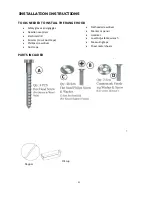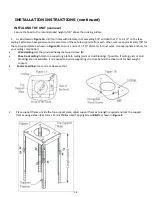
INSTALLATION INSTRUCTIONS (continued)
BEFORE INSTALLING THE HOOD
▪
For the most efficient airflow exhaust use a straight run or as few elbows as possible.
▪
Vent unit to the outside only.
▪
At least two people are required for installation.
▪
Remove the range hood from the carton packaging and place on a flat surface for assembly.
ELECTRIC REQUIREMENTS
CAUTION: THIS APPLIANCE SHOULD BE PROPERLY GROUNDED
.
▪
This hood must be power supplied 120 V, 60 Hz and connected to an individual, properly grounded circuit (3-prong
outlet).
▪
If the electrical supply does not meet above requirements, call a licensed electrician before proceeding.
▪
Route house wiring as close as possible to the installation location, in the ceiling.
▪
The hood must be connected to the house wiring in accordance with the local codes and norms
.
WALL FRAMING FOR ADEQUATE SUPPORT
THIS VENT HOOD IS HEAVY. ADEQUATE STRUCTURE AND SUPPORT MUST BE PROVIDED IN ALL TYPES OF
INSTALLATIONS. IF MOUNTING ON DRY WALL, THE HOOD MUST BE SECURED TO A HORIZONTAL SUPPORT.
PREPARING THE INSTALLATION
▪
For evacuation toward the exterior only.
▪
For domestic use only. Do not use to evacuate dangerous or explosives fumes or materials.
Option 1: Vertical venting
Option 2: Horizontal venting
▪
Determine and mark the exact location of the vent hood. Find the centerline of the cooktop. Use a level to draw a
vertical straight pencil line on the wall.
▪
Plan the route for venting exhaust to the outdoors. Use the shortest and straightest duct route possible. Long duct
runs, elbows and transitions will reduce the performance of the hood. Use as few as possible. Larger ducting may
be required for longer duct runs.
▪
Install a wall cap with damper or roof cap at the exterior opening/wall. Add the wall or roof cap to the ductwork.
▪
Connect round metal ductwork to cap and work back towards the hood location and seal joints with 2" metal foil.
Roof cap
d
Wall cap
A minimum of 30
’’
above a cooking
surface is required
22









































